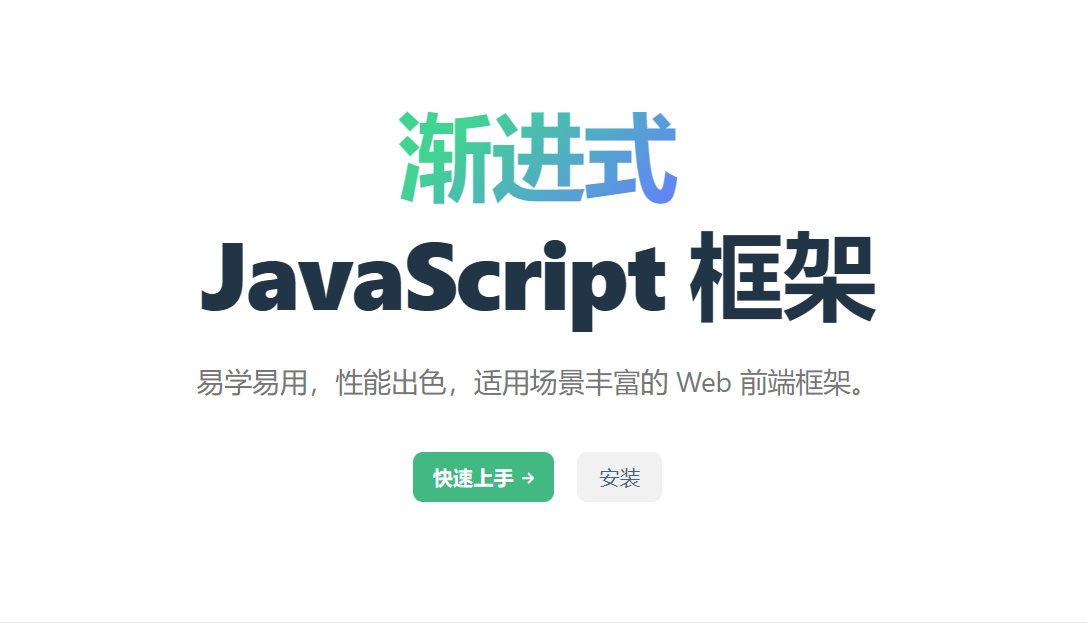VUE学习之路 1day 关于vue 易学易用 基于标准 HTML、CSS 和 JavaScript 构建,提供容易上手的 API 和一流的文档。
性能出色 经过编译器优化、完全响应式的渲染系统,几乎不需要手动优化。
灵活多变 丰富的、可渐进式集成的生态系统,可以根据应用规模在库和框架间切换自如。
vue环境安装 下载node.js 版本 1.15以上
安装命令
1 2 3 4 5 6 7 8 9 10 11 12 13 14 15 16 17 18 19 20 21 22 23 24 25 26 $ cd 指定目录 $ npm init vue@latest Need to install the following packages: create-vue@3.6.1 Ok to proceed? (y) y Vue.js - The Progressive JavaScript Framework # 这里需要进行一些配置,项目名输入 runoob-vue3-test,其他默认回车即可 ✔ Project name: … crrot //不能有大写或者中文 ✔ Add TypeScript? … No / Yes ✔ Add JSX Support? … No / Yes ✔ Add Vue Router for Single Page Application development? … No / Yes ✔ Add Pinia for state management? … No / Yes ✔ Add Vitest for Unit Testing? … No / Yes ✔ Add an End-to-End Testing Solution? › No ✔ Add ESLint for code quality? … No / Yes Scaffolding project in /Users/tianqixin/runoob-test/runoob-vue3/runoob-vue3-test... Done. Now run: cd runoob-vue3-test npm install npm run dev
运行成功后出现
1 2 3 4 5 6 7 VITE v5.0.11 ready in 372 ms ➜ Local: http://localhost:5173/ ➜ Network: use --host to expose ➜ press h + enter to show help 12:25:06 [vite] hmr update /src/App.vue 12:25:46 [vite] hmr update /src/App.vue (x2)
直接访问就好了
模板语法 基本模板使用
1 2 3 4 5 6 7 8 9 10 11 12 13 <template> <h3>模板语法</h3> <p>{{ msg }}</p> </template> <script> export default { data() { return{ msg:"模板语法", } } } </script>
1 2 3 4 5 6 7 8 9 10 11 12 13 14 15 16 17 18 19 20 21 <template> <h3>语法</h3> <p>{{ msg }}</p> //输出 <p>{{ ok ? 'yes': 'no' }}</p> //布尔值判断 <p>{{ nub + 1 }}</p> //模板赋值 <p>{{ message }}</p> <p v-html="rwhtml"></p> //引用html代码 </template> <script> export default { data() { return{ msg:"神器的语法", nub:10, ok:true, message:"大家好阿", rwhtml:"<a href='https:www.baidu.com/'>百度</a>", } } } </script>
输出
1 2 3 4 5 6 7 8 9 10 语法 神器的语法 yes 11 大家好阿 百度
属性赋值 将 class值赋值给 标签
1 2 3 4 5 6 7 8 9 10 11 12 13 <template> <p :class="class">{{msg}}</p> // :class 也可写成 v-bind:class </template> <script> export default{ data(){ return{ msg:"Hello", class:'carrot', } } } </script>
多动态赋值
1 2 3 4 5 6 7 8 9 10 11 12 13 14 15 16 <template> <p v-bind="object">{{msg}}</p> // :class 也可写成 v-bind:class </template> <script> export default{ data(){ return{ msg:"Hello", object:{ class:"carrot", id:"carrot", }, } } } </script>
结果图!
条件渲染 在vue中提供了很多条件渲染 类似javascript 的条件语句
v-if
v-else
v-else-if
v-show
v-if 1 2 3 4 5 6 7 8 9 10 11 12 13 14 15 16 17 <template> <h1>{{msg}}</h1> <div v-if="ok"> 弹出东西来咯 </div> </template> <script> export default{ data(){ return{ msg:"if条件练习", ok:false, //控制条件 } } } </script>
用布尔型控制标签显示与不显示
v-else 1 2 3 4 5 6 7 8 9 10 11 12 13 14 15 16 17 18 19 20 <template > <h1 > {{msg }} </h1 > <div v-if ="ok" > 弹出东西来咯 </div > <div v-else ="ok" > 上面看不到可以看到我哦 </div > </template > <script > export default { data ( return { msg :"if条件练习" , ok :false , } } } </script >
如果上面 v-if 为ture 那么就显示 弹出东西来咯 如果v-if 为false 就显示 上面看不到可以看到我哦
v-else-if 1 2 3 4 5 6 7 8 9 10 11 12 13 14 15 16 17 18 <template> <h1>{{msg}}</h1> <div v-if="ok">弹出东西来咯</div> <div v-else-if="nub==10">等于10</div> div v-else-if="nub==20">等于20</div> </template> <script> export default{ data(){ return{ msg:"if条件练习", ok:false, nub:10, } } } </script>
输出等于10
v-show 与v-if 差不多 但是 v-show没有条件,只能判断 ture and false
1 2 3 4 5 6 7 8 9 10 11 12 13 14 15 <template> <h1>{{msg}}</h1> <div v-if="ok">弹出东西来咯</div> </template> <script> export default{ data(){ return{ msg:"v-show条件练习", ok:false, //控制条件 } } } </script>
列表渲染 可以用 v-for 来渲染数组列表,类似于遍历数组
v-for 指令的值需要使用项目中的项目 item in items 形式的特殊语法其中 items 是源数据的数组,而 item 是选代项的别名
1 2 3 4 5 6 7 8 9 10 11 12 13 14 15 <!-- 列表渲染 --> <template> <h3>{{ msg }}</h3> <p v-for="item in name">{{ item }}</p> </template> <script> export default{ data(){ return{ msg:'列表渲染', name:['carrot','我爱网安','世界第一'] } } } </script>
输出结果
输出下标
1 <p v-for="(item,index) in name">{{ item }}-{{ index }}</p>
1 2 3 4 5 6 输出: carrot-0 我爱网安-1 世界第一-2
渲染网页json 1 2 3 4 5 6 7 8 9 10 11 12 13 14 15 16 17 18 19 20 21 <!-- 渲染列表 --> <template> <h3>{{ msg }}</h3> <p v-for="item in name">{{ item }}</p> <div v-for="web in webjs"> <p>标题:{{ web.title }}</p> <p>内容:{{ web.text }}</p> </div> </template> <script> export default{ data(){ return{ msg:'列表渲染', name:['carrot','我爱网安','世界第一'], webjs:[{"id":1,title:"Carrot",text:"这是来自carrot的内容,收到请回答"}], } } } </script>
输出:
1 2 3 标题:Carrot 内容:这是来自carrot的内容,收到请回答
遍历对象
有三个参数
1 2 3 4 5 6 7 8 9 10 11 12 13 14 15 16 17 18 19 20 21 22 23 24 25 26 27 28 <!-- 渲染列表 --> <template> <h3>{{ msg }}</h3> <p v-for="(item,index) in name">{{ item }}-{{ index }}</p> <div v-for="web in webjs"> <p>标题:{{ web.title }}</p> <p>内容:{{ web.text }}</p> </div> <!-- 遍历对象 --> <p v-for="(value,key,index) in userifo">{{ value }}-{{ key }}-{{ index }}</p> //key对应的是键值 value 是内容 idnex 是下标 </template> <script> export default{ data(){ return{ msg:'列表渲染', name:['carrot','我爱网安','世界第一'], webjs:[{"id":1,title:"Carrot",text:"这是来自carrot的内容,收到请回答"}], userifo:{ name:"carrot", age:"10086", sex:"male", } } } } </script>
输出
1 2 3 4 5 carrot -name-0 10086 -age-1 male -sex-2
1 2 3 //key添加唯一索引 vue3中不报错 在vue2中必须添加key <p v-for="(item,index) in name" :key="index">{{ item }}-{{ index }}</p>






